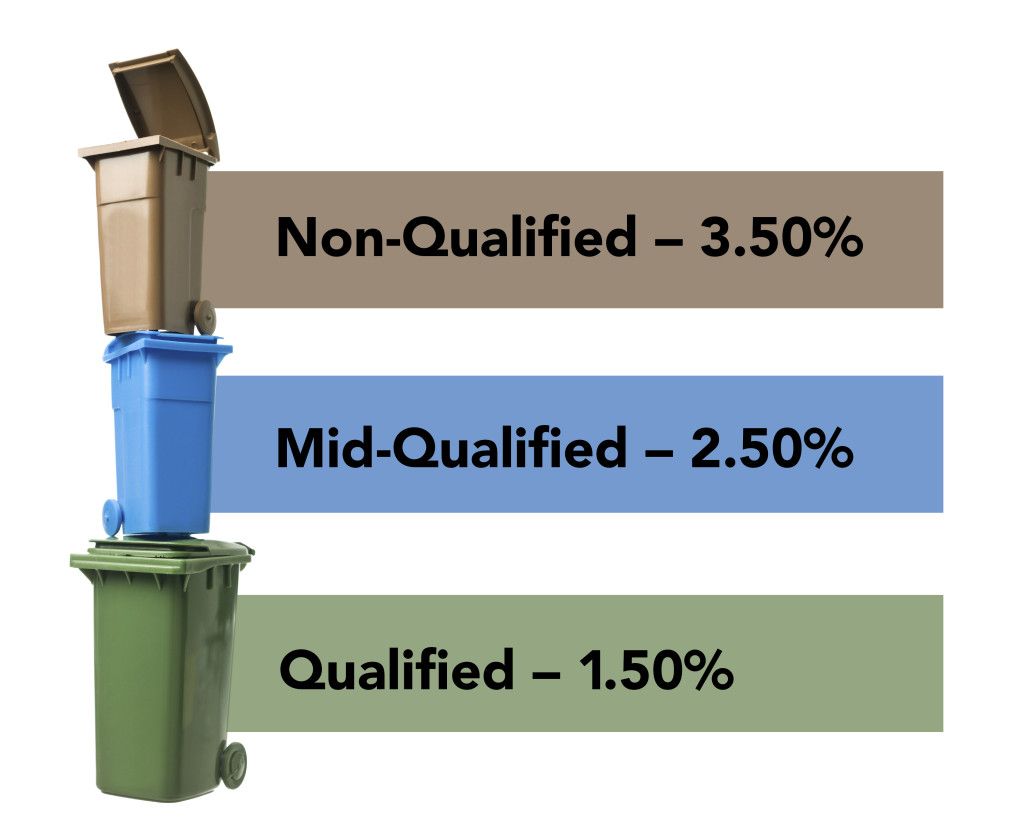 There are two prevailing schools of thought when it comes to credit card processing fees. And, chances are that—if your business accepts credit cards—you’re set up under one of these fee structures: Tiered Rate or Interchange Plus. Knowing the difference between the two can have a direct and tangible impact on your bottom line.
There are two prevailing schools of thought when it comes to credit card processing fees. And, chances are that—if your business accepts credit cards—you’re set up under one of these fee structures: Tiered Rate or Interchange Plus. Knowing the difference between the two can have a direct and tangible impact on your bottom line.
A quick explanation of “interchange rates”
For each credit card transaction, a business pays processing fees—a percentage of the sale amount. The percentage rate can range anywhere from 0.25 to 3+ percent and is largely determined by the card issuer (i.e. Visa, MasterCard, etc.). Each issuer sets a percentage rate associated with not only the type of card used for the transaction, but also the way in which that card is presented (swiped vs. key-entered). This rate is commonly referred to as the “interchange rate” and serves as the wholesale rate for any given transaction.
Now that we’ve defined what interchange rates are, let’s take a look at the fee pricing models.
The Tiered Rate Dumpsters: Let’s dive in!
As a homeowner in Waco, TX, the City of Waco has furnished me with three lovely receptacles in which to deposit the waste I produce each week. They’ve even color-coded them to make sure that I don’t accidentally put yard waste into the recycle dumpster, or vice versa.
Now, very rarely do I completely fill up any one of these dumpsters during a given week. Some weeks, there’s actually quite a bit of extra space when I take my dumpsters to the curb for their weekly pick-up.
The tiered rate pricing model works in a similar fashion, in which transactions are classified into three categories: qualified (trash), mid-qualified (recyclables) and non-qualified (yard waste). And, each dumpster is assigned a rate. So, for the purposes of our explanation, let’s say that the merchant services provider has assigned the following rates to our tiered dumpsters:

As a general rule of thumb, swiped cards (where the card is swiped with a credit card machine) are generally placed in the qualified dumpster, while key-entered cards would fall into the mid or non-qualified dumpsters.
With the tiered rate pricing structure, it helps to know that the service provider’s profit is represented by the difference between the interchange rate, which we covered earlier, and the dumpster rate charged to the merchant by the service provider.
Pros and Cons of Tiered Rate Pricing
The tiered rate pricing structure makes it pretty easy for a business to predict what their processing fees are going to be. For instance, if most of the transactions are swiped, a business generally knows that all their transactions, regardless of the interchange rate, are going to come through at 1.50% or 2.50%. There’s little variation in the fees from month to month. Some businesses like the clarity they receive in knowing that there are only three possible rates that their transactions could receive.
The reason the tiered rate pricing model is actually used less frequently today is because it has proven difficult for service providers to accurately peg the rates associated with each dumpster. For instance, if a service provider pegs the mid-qualified dumpster at 2.25%, only to realize that the majority of the interchange rates associated with the merchant’s actual sales are coming in at 2.50%, then the service provider is ultimately losing money on that merchant’s transactions. And, nobody likes to lose money.
So, many service providers overcompensate and build in generous cushions—like all that extra space in my yard waste dumpster each week—to ensure no losses are incurred. This usually results in merchants paying more than they should.
Then, what’s so great about Interchange Plus?
To most, the interchange plus pricing model is considered a win-win. The merchant services provider benefits from having a consistent profit margin in place, and the business benefits when transactions receive lower interchange rates. So, how does Interchange Plus work?
Well, the merchant services provider takes the interchange rate for any given transaction and super-imposes a “discount rate” on top. For the purposes of example, let’s assume an interchange rate of 1.50% and a discount rate of 0.50%. For this particular transaction, the merchant would pay 2% (1.50% + 0.50% = 2%) of the sales price in processing fees. If, on the next transaction, the card had an interchange rate of 1%, then the merchant would pay 1.5% (1% + 0.50% = 1.50%) of the sales price.
Under the interchange plus model, the merchant benefits from transactions that incur lower interchange rates, whereas with tiered rate, these lower-priced transactions would be marked up to the dumpster rate, causing the business to pay more. The cost difference can add up, especially over time.
How is the “plus” in Interchange Plus determined?
The discount rate (the “plus”) is set by the merchant services provider and is typically some function of a merchant’s sales volume and average sale amount. So long as the merchant isn’t perceived to be in a high-risk industry, businesses with higher annual credit card sales generally receive lower discount rates.
Depending on sales volume, the discount rate can range from 20 basis points (0.20%) to 75 basis points (0.75%).
As most businesses know, there are other fees associated with a typical merchant account, but the bulk of those fees are represented by the percentage rate paid for each transaction. And, understanding how that portion of your fees is calculated—Tiered Rate or Interchange Plus—can result in real gains to a business’ bottom line.


